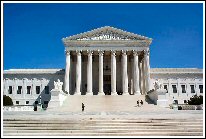TocDocuments
Essays
Biographies
Presidents
About
Project
Awards
The team
Contributions
Info
Disclaimer
Copyright
Sponsoring
Navigation
Guestbook
Printing
FRtR > Outlines > The American Government > The Judicial Branch: Interpreting the Constitution > The Supreme Court
An Outline of American Government
The Judicial Branch: Interpreting the Constitution
The Supreme Court
*** Index * < Previous Chapter * Next Chapter > ***
 The Supreme Court is the
highest court of the United States, and
the only one specifically created by the Constitution. A
decision of the Supreme Court cannot be appealed to any other
court. Congress has the power to fix the number of judges
sitting on the Court and, within limits, decide what kind of
cases it may hear, but it cannot change the powers given to the
Supreme Court by the Constitution itself.
The Supreme Court is the
highest court of the United States, and
the only one specifically created by the Constitution. A
decision of the Supreme Court cannot be appealed to any other
court. Congress has the power to fix the number of judges
sitting on the Court and, within limits, decide what kind of
cases it may hear, but it cannot change the powers given to the
Supreme Court by the Constitution itself.
The Constitution is silent on the qualifications for judges. There is no requirement that judges be lawyers, although, in fact, all federal judges and Supreme Court justices have been members of the bar.
Since the creation of the Supreme Court almost 200 years ago, there have been slightly more than 100 justices. The original Court consisted of a chief justice and five associate justices. For the next 80 years, the number of justices varied until, in 1869, the complement was fixed at one chief justice and eight associates. The chief justice is the executive officer of the Court but, in deciding cases, has only one vote, as do the associate justices.
The Supreme Court has original jurisdiction in only two kinds of cases: those involving foreign dignitaries and those in which a state is a party. All other cases reach the Court on appeal from lower courts.
Of the several thousand cases filed annually, the Court usually hears only about 150. Most of the cases involve interpretation of the law or of the intent of Congress in passing a piece of legislation. A significant amount of the work of the Supreme Court, however, consists of determining whether legislation or executive acts conform to the Constitution. This power of judicial review is not specifically provided for by the Constitution. Rather, it is doctrine inferred by the Court from its reading of the Constitution, and forcefully stated in the landmark Marbury vs. Madison case of 1803. In its decision in that case, the Court held that "a legislative act contrary to the Constitution is not law," and further observed that "it is emphatically the province and duty of the judicial department to say what the law is." The doctrine has also been extended to cover the activities of state and local governments.
Decisions of the Court need not be unanimous; a simple majority prevails, provided at least six justices -- the legal quorum -- participate in the decision. In split decisions, the Court usually issues a majority and a minority -- or dissenting -- opinion, both of which may form the basis for future decisions by the Court. Often justices will write separate concurring opinions when they agree with a decision, but for reasons other than those cited by the majority.
*** Index * < Previous Chapter * Next Chapter > ***
for From Revolution to Reconstruction - an .HTML project.
Last update: 2025-4-20 time: 04:27
© 1994- 2007. All rights reserved.
Department of Humanities Computing